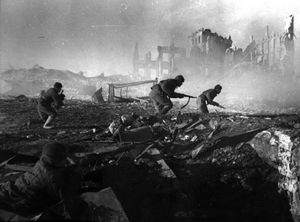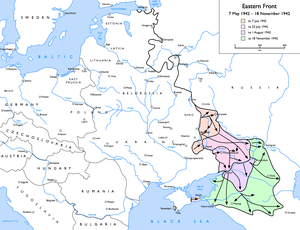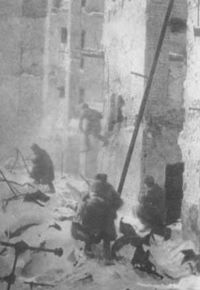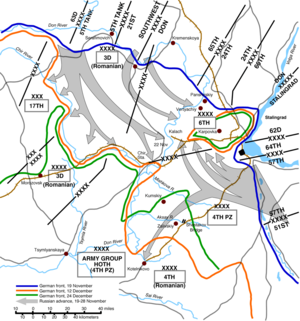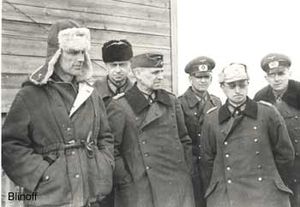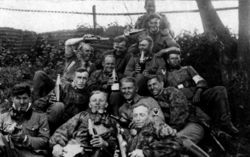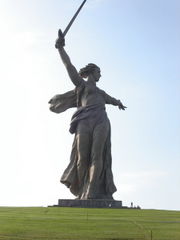Battle of Stalingrad
2007 Schools Wikipedia Selection. Related subjects: World War II
| Battle of Stalingrad | |||||||
|---|---|---|---|---|---|---|---|
| Part of World War II | |||||||
|
Soviet soldiers fighting in the ruins of Stalingrad, 1942 |
|||||||
|
|||||||
| Combatants | |||||||
| Commanders | |||||||
| Friedrich Paulus Erich von Manstein Hermann Hoth |
Georgiy Zhukov Vasiliy Chuikov Aleksandr Vasilyevskiy |
||||||
| Strength | |||||||
| German Sixth Army German Fourth Panzer Army Romanian Third Army Romanian Fourth Army Hungarian Second Army Italian Eighth Army 500,000 Germans Unknown number Reinforcements Unknown number Axis-allies |
Stalingrad Front Southwestern Front Don Front 1,700,000 |
||||||
| Casualties | |||||||
| 740,000 killed or wounded 110,000 captured |
750,000+ killed, wounded or captured 40,000+ civilian dead |
||||||
| Eastern Front |
|---|
| Barbarossa – Finland – Leningrad and Baltics – Crimea and Caucasus – Moscow – 1st Rzhev-Vyazma – 2nd Kharkov – Stalingrad – Velikiye Luki – 2nd Rzhev-Sychevka – Kursk – 2nd Smolensk – Dnieper – 2nd Kiev – Korsun – Hube's Pocket – Belorussia – Lvov-Sandomierz – Balkans – Hungary – Vistula-Oder – Königsberg – Berlin – Prague |
| Operation Blue to 3rd Kharkov |
|---|
| Blue – Voronezh – Edelweiss – Stalingrad – Uranus – Winter Storm – Saturn – Tatsinskaya Raid – 3rd Kharkov |
The Battle of Stalingrad was the most important turning point of World War II and is considered the bloodiest battle in human history, with more combined casualties suffered than any battle before or since. The battle was marked by brutality and disregard for military and civilian casualties on both sides. The battle is taken to include the German siege of the southern Russian city of Stalingrad (now Volgograd), the battle inside the city, and the Soviet counter-offensive which eventually trapped and destroyed the German Sixth Army and other Axis forces around the city. Total casualties for both sides are estimated to be over two million. As a result of the battle, the Axis powers suffered roughly 850,000 casualties, 1/4 of their strength on the Eastern Front, as well as a huge amount of supplies and equipment. The Axis forces were never able to recover from this loss and were eventually forced into a long retreat out of Eastern Europe. For the Soviets, who also suffered great losses during the battle, the victory at Stalingrad marked the start of the liberation of the Soviet Union leading to eventual victory over Nazi Germany in 1945.
Besides being a turning point in the war, Stalingrad was also revealing in terms of the discipline and determination of both the German and Soviet armies. The Soviets first defended Stalingrad against a fierce German onslaught. So great were Soviet losses that at points in time the life expectancy of a newly arrived soldier was less than a day, yet discipline was maintained and soldiers gave their lives rather than retreat. Their sacrifice is immortalized by a soldier of General Rodimstev about to die who scratched on the wall of the tractor factory 'Rodimstev's Guardsmen fought and died here for their motherland (rodina)'. Next, after being surrounded, the German Army showed remarkable discipline. It was the first time that it had operated under adverse conditions of such scale. Short of food and clothing, during the latter part of the siege many German soldiers literally starved or froze to death. Yet, discipline and obedience to authority prevailed, until finally at the very end when resistance no longer served any useful purpose, to save the lives of his remaining men Field Marshal Friedrich Paulus disobeyed Hitler and surrendered.
Background
On June 22, 1941, Germany and its Axis allies invaded the Soviet Union, quickly advancing deep into Soviet territory. Having suffered defeat during the summer and autumn of 1941, Soviet forces counter-attacked in the Battle of Moscow in December. Then the exhausted German forces, ill equipped for winter warfare and with overstretched supply lines, were stopped in their drive towards the capital.
The Germans stabilized their front by spring 1942. Plans to launch another offensive against Moscow were discarded however, as Army Group Centre had been too heavily weakened. Part of the German military philosophy was to attack where least expected, so that rapid gains could be made. An attack on Moscow was seen as too predictable by some, most notably Hitler. Along with this, the German high command knew that time was running out for them, as the United States had entered WWII following the Japanese attack on Pearl Harbour. Hitler wanted to end the fighting on the Eastern Front or at least minimize it before the US had a chance to get deeply involved in the war in Europe.
Importance of Stalingrad
The capture of Stalingrad was important to Hitler for several reasons. It was a major industrial city on the banks of the river Volga (a vital transport route between the Caspian Sea and northern Russia). Its capture would secure the left flank of the German armies as they advanced into the Caucasus. Finally, the fact that the city bore the name of Hitler's nemesis, Joseph Stalin, would make the city's capture an ideological and propaganda coup.
It is believed that Stalin also had an ideological and propaganda interest in defending the city which bore his name, but the fact remains that Stalin was doing the best he could given the time and resources. Some believe that the siege of Leningrad lasted too long due to his diversion of forces from Leningrad to Stalingrad, which is false. During the Russian Civil War he played a prominent role in the Red defense of the city, then known as Tsaritsyn, from White forces. Also, the Red Army, at this stage of the war, was less capable of highly mobile operations than the German army. The prospect of combat inside a large urban area, which would be dominated by infantry and artillery, maximized the Red Army's advantages against the Germans.
Operation Blau / Blue
Army Group South was selected for a sprint forward through the southern Russian steppes into the Caucasus to capture the vital Soviet oil fields. These oil fields were a key goal for Hitler and instead of focusing his attention on the key capital of Moscow as his generals advised, he continued to send his forces and supplies to the southern Russian front. The summer offensive was code-named Fall Blau (literally: "Case Blue"). It was to include the 6th and 17th Armies and the 4th and 1st Panzer Armies. In 1941, Army Group South had conquered Ukraine, and was positioned at the area of the planned offensive.
Hitler intervened, however, ordering the Army Group to be split in two. Army Group South (A), under the command of Paul Ludwig Ewald von Kleist, was to continue advancing south towards the Caucasus as planned with the 17th and 1st Panzer Armies. Army Group South (B), including Friedrich Paulus' 6th Army and Hermann Hoth's 4th Panzer Army, was to move east towards the river Volga and the city of Stalingrad.
The start of Operation Blau had been planned for late May 1942. However, a number of German and Romanian units that were involved in Blau were then in the process of besieging Sevastopol on the Crimean Peninsula. Delays in ending the siege pushed back the start date for Blau several times, and the city did not fall until the end of June. A smaller action was taken in the meantime, pinching off a Soviet salient in the Second Battle of Kharkov, which resulted in the pocketing of a large Soviet force on 22 May.
Blau finally opened as Army Group South began its attack into southern Russia on June 28, 1942. The German offensive started well. Soviet forces offered little resistance in the vast empty steppes, and started streaming eastward in disarray. Several attempts to form defensive lines failed when other German units flanked Soviet defensive lines. Two major pockets were formed and destroyed, the first northeast of Kharkov on June 2, a second around Millerovo, Rostov Oblast a week later.
Meanwhile the 2nd Hungarian Army and the 4th Panzer Army had launched an assault on Voronezh, capturing the city on 5 July.
The initial advance of the 6th Army was so successful that Hitler intervened, and ordered the 4th Panzer Army to join Army Group South (A) to the south. A massive traffic jam resulted when the 4th Army and the 6th Army both required the few roads in the area. Both armies were stopped dead while they attempted to clear the resulting mess of thousands of vehicles. The delay was long, and it is thought that it cost the advance at least one week. With the advance now slowed, Hitler changed his mind and re-assigned the 4th Panzer back to the attack on Stalingrad.
By the end of July the Germans had pushed the Soviets across the Don River. At this point the Germans established defensive lines using the Armies of their Italian, Hungarian and Romanian allies. The 6th Army was only a few dozen kilometers from Stalingrad, and the 4th Panzer, now to their south, turned north to help take the city. To the south, Group A was pushing far into the Caucasus, but their advance slowed. Group A's forces were deployed far to the south and provided no support to Group B in the north.
Now German intentions became clear to the Soviet commanders: in July Soviet plans were developed for the defense in Stalingrad. Soviet troops still moving eastward before the Germans offensive were ordered into Stalingrad. The eastern border of Stalingrad was the broad Volga river, and over the river additional Soviet units were deployed. This combination of units became the newly formed 62nd Army under the command of Vasily Chuikov. Its mission was to defend Stalingrad at all costs.
In the city
The battle began with the heavy bombing of the city by the Luftwaffe. The sprawling metropolis became a graveyard. Many died once the battle began and the city became a shell of what it once was. Still, many buildings survived and Soviet patriotism shone through. Many factory workers joined in the fighting.
Stalin prevented civilians from leaving the city on the premise that their presence would encourage greater resistance from the city's defenders. Civilians, including women and children, were put to work building trenchworks and protective fortifications. A massive German air bombardment on 23 August caused a firestorm, killing thousands and turning Stalingrad into a vast landscape of rubble and burnt ruins. 80% of the living space in the city was destroyed.
The burden of the initial defense of the city proper fell on the 1077th Anti-aircraft regiment, a unit made up mainly of young women volunteers who had no training on engaging ground targets. Despite this and with no support available from other Soviet units, the AA gunners stayed at their posts and took on the advancing panzers. The 16th Panzer Division reportedly had to fight the 1077th's gunners "shot for shot" until all 37 AA batteries were destroyed or overrun. In the beginning, the Soviets relied extensively on "Workers militias" composed of workers not directly involved in war production. For a short time, tanks continued to be produced and then manned by volunteer crews of factory workers. They were driven directly from the factory floor to the front line, often without paint or even gunsights.
By the end of August, Army Group South (B) had finally reached the Volga to the north of Stalingrad. Another advance to the river south of the city followed. By September 1, 1942, the Soviets could only reinforce and supply their forces in Stalingrad by perilous crossings of the Volga, under constant bombardment by German artillery and planes.
Amid the debris of the wrecked city, the Soviet 62nd Army anchored their defense lines with strongpoints in houses and factories. Fighting was fierce and desperate. The life expectancy of a newly-arrived Soviet private in the city dropped to less than twenty-four hours. Stalin's Order No. 227 of July 27, 1942 decreed that all those who retreated or otherwise left their positions without orders could be summarily shot. "Not a step back!" was the slogan. The Germans pushing forward into Stalingrad suffered heavy casualties.
German military doctrine was based on the principle of combined-arms teams and close co-operation by tanks, infantry, engineers, artillery, and ground-attack aircraft. To counter this, Soviet commanders adopted the simple expedient of always keeping the front lines as close together as physically possible. Chuikov called this tactic "hugging" the Germans. This forced the German infantrymen to either fight on their own or risk taking casualties from their own supporting fire; it neutralized German close air support and weakened their artillery support. Bitter fighting raged for every street, every factory, every house, basement and staircase. The Germans, calling this unseen urban warfare Rattenkrieg ("rat-war"), bitterly joked about capturing the kitchen but still fighting for the living-room.
Fighting on Mamayev Kurgan, a prominent, blood-soaked hill above the city, was particularly merciless. The height changed hands many times. During one Soviet counter-attack, the Russians lost an entire division of 10,000 men in one day. At the Grain Elevator, a huge grain processing complex dominated by a single enormous silo, combat was so close that Soviet and German soldiers could hear each other breathe. Combat raged there for weeks until the German army reduced the opposition. In another part of the city, a Soviet platoon under the command of Yakov Pavlov turned an apartment building into an impenetrable fortress. The building, later called " Pavlov's House", oversaw a square in the city centre. The soldiers surrounded it with minefields, set up machine-gun positions at the windows, and breached the walls in the basement for better communications.
With no end in sight, the Germans started transferring heavy artillery to the city, including a gigantic 800 mm mortar. The Germans made no effort to send a force across the Volga, allowing the Soviets to build up a large number of artillery batteries there. Soviet artillery on the eastern bank continued to bombard the German positions. The Soviet defenders used the resulting ruins as defensive positions. German tanks became useless amid heaps of rubble up to eight meters high. When they were able to move forward, they came under Soviet anti-tank fire from building wrecks.
Soviet snipers also successfully used the ruins to inflict heavy casualties on the Germans. The most successful sniper was Ivan Mihailovich Sidorenko of the 1122nd rifle regiment who had made approximately 500 kills by the end of the war. . Vasily Grigoryevich Zaitsev was credited with 242 kills during the battle. He was also thought to have killed an infamous German sniper by the name of Heinz Thorvald, but this claim was never confirmed.
For both Stalin and Hitler, the battle of Stalingrad became a prestige issue, on top of the actual strategic significance of the battle. The Soviet command moved the Red Army's strategic reserves from the Moscow area to the lower Volga, and transferred aircraft from the entire country to the Stalingrad region. The strain on both military commanders was immense: Paulus developed an uncontrollable tic in his eye, while Chuikov experienced an outbreak of eczema that required him to bandage his hands completely. The troops on both sides faced the constant strain of close-range combat.
In November, after three months of carnage and slow and costly advance, the Germans finally reached the river banks, capturing 90% of the ruined city and splitting the remaining Soviet forces into two narrow pockets. In addition, ice-floes on the Volga now prevented boats and tugs from supplying the Soviet defenders across the river. Nevertheless the fighting, especially on the slopes of Mamayev Kurgan and inside the factory area in the northern part of the city, continued as fiercely as ever. The battles for the Red October steel factory, the Dzerzhinsky tractor factory and the Barrikady gun factory became world famous. While Soviet soldiers defended their positions and took the Germans under fire, factory workers repaired damaged Soviet tanks and other weapons close to the battlefield, sometimes on the battlefield itself.
The Soviet counter-offensive: Operation Uranus
During the siege the German, Hungarian, and Romanian armies protecting Army Group South (B)'s flanks had pressed their headquarters for support. The 2nd Hungarian Army (consisting of mainly ill-equipped and ill-trained units) were given the task of defending a 200 km section of the front north of Stalingrad. This resulted in a very thin line of defense with some parts where 1-2km stretches were being guarded by a single platoon. Soviet forces held several points on the south bank of the river and presented a potentially serious threat to Army Group South (B). However, Hitler was so focused on the city itself that requests from the flanks for support were refused. The chief of the Army General Staff OKH, Franz Halder, expressed concerns about Hitler's preoccupation with the city, pointing at the Germans' weak flanks. Hitler replaced Halder in mid-October with General Kurt Zeitzler.
In Autumn the Soviet general Georgy Zhukov, responsible for strategic planning in the Stalingrad area, concentrated massive Soviet forces in the steppes to the north and south of the city. The German northern flank was particularly vulnerable, since it was defended by Hungarian and Romanian units which suffered from inferior equipment and low morale. Zhukov's plan was to keep pinning the Germans down in the city, and then to punch through the overstretched and weakly defended German flanks and to surround the Germans inside Stalingrad. The operation was code-named " Uranus" and launched in conjunction with Operation Mars, which was directed at Army Group Centre.
On November 19, 1942 the Red Army unleashed Uranus. The attacking Soviet units under the command of General Nikolai Vatutin consisted of three complete armies, the 1st Guards Army, 5th Tank Army, and 21st Army, including a total of 18 infantry divisions, eight tank brigades, two motorized brigades, six cavalry divisions and one anti-tank brigade. The preparations for the attack could be heard by the Romanians, who continued to push for reinforcements, only to be refused again. Thinly spread, outnumbered and poorly equipped, the 3rd Romanian Army, which held the northern flank of the German 6th Army, was shattered after an almost miraculous one-day defense.
On November 20, a second Soviet offensive (two armies) was launched to the south of Stalingrad, against points held by the Romanian 4th Army Corps. The Romanian forces, made up primarily of cavalry, collapsed almost immediately. Soviet forces raced west in a pincer movement, and met two days later near the town of Kalach, sealing the ring around Stalingrad. The Russians filmed this linkup to later use as propaganda, and the piece of footage is famous today; however, the footage is not of the actual linkup. Instead, the Russians had to stage and film it later after the initial link-up because they had no cameras available the first time. Because of this brilliant pincer attack, about 250,000 German and Romanian soldiers, as well as some Croatian units and volunteer subsidiary troops found themselves trapped inside the resulting pocket. This pocket was known in Germany as Der Kessel (The Cauldron). Inside the pocket there were also the surviving Soviet civilians - around 10,000 , and several thousands of Soviet soldiers whom the Germans had taken captive during the battle. Not all German soldiers from the 6th Army were trapped: 50,000 were brushed aside outside the pocket. The encircling Red Army units immediately formed two defensive fronts: one facing 'inward' to defend against breakout attempt by the surrounded Germans, the other facing 'outward' to defend against any relief attempt.
Adolf Hitler had already declared in a public speech on September 30 that the German army would never leave the city. At a meeting shortly after the encirclement, German army chiefs pushed for an immediate breakout to a new line on the west of the Don. However, Hitler was at his Bavarian retreat of Obersalzberg in Berchtesgaden with the head of the Luftwaffe, Jeschonnek. When asked by Hitler, Jeschonnek replied, without much thought, that the Luftwaffe could supply the 6th Army with an "air bridge." This would allow the Germans in the city to fight on while a relief force could be assembled, a plan that had been used successfully a year earlier at the Demyansk Pocket on a much smaller scale (an army corps versus an entire army). This reinforced Hitler's own views and was endorsed by Hermann Göring several days later. The head of the 4th Air Fleet (Luftflotte 4), Wolfram von Richthofen, tried in vain to overturn this decision without success. The 6th Army would be supplied by air. The German Sixth Army was the largest unit of this type in the world, almost twice as large as a regular German army. Also trapped in the "pocket" was a corps of the Fourth Panzer Army. It should have been clear that supplying the pocket by air was impossible: the Luftwaffe's carrying capacity after the Battle of Crete had not been reinforced, and the maximum 300 tonnes they could deliver a day would be less than the 500 needed by the pocket. However, Hitler backed Göring's plan and re-iterated his order of "no surrender" to his trapped armies.
The air supply mission failed almost immediately. Heavy Soviet anti-aircraft fire and fighter interceptions led to the loss of many German transport aircraft. The winter weather reduced the flying efficiency of the German air force. In general, only 10 percent of the needed supplies could be delivered. Those transport planes which made it would evacuate technical specialists and sick or wounded men when taking off from the besieged enclave. The 6th Army slowly starved. Pilots were shocked to find the troops assigned to offloading the planes too exhausted and hungry to unload food. One general at the German high command, moved by the troops' plight at Stalingrad, began to limit himself to their slim rations at meal times. After a few weeks of such a diet he'd grown so emaciated that Hitler, annoyed, personally ordered him to start eating regular meals again.
Soviet forces consolidated their positions around Stalingrad, and fierce fighting to shrink the pocket began. An attack by a German battlegroup formed to relieve the trapped armies from the South, Operation Wintergewitter ("Winter Storm") was successfully fended off by the Soviets in December. The full impact of the harsh Russian winter set in. The Volga froze solid, allowing the Soviets to supply their forces in the city more easily. The trapped Germans rapidly ran out of heating fuel and medical supplies, and thousands started dying of frostbite, malnutrition and disease.
On December 16 the Soviets launched a second offensive, Operation Saturn, which attempted to punch through the Axis army on the Don and take Rostov. If successful, this offensive would have trapped the remainder of Army Group South in the Caucasus. The Germans set up a "mobile defense" in which small units would hold towns until supporting armor could arrive. The Soviets never got close to Rostov, but the fighting forced von Manstein to extract Group A from the Caucasus and restabilize the frontline some 250 km away from the city. The Tatsinskaya Raid also caused significant losses to Luftwaffe's transport fleet. The 6th Army was now beyond all hope of German reinforcement. The German troops in Stalingrad were not told this, however, and continued to believe that reinforcements were on their way. Some German officers requested that Paulus defy Hitler's orders to stand fast and instead attempt to break out of the Stalingrad pocket. Paulus refused, as he abhorred the thought of disobeying orders. Also, whereas a breakout may have been possible in the first few weeks, at this late stage the 6th Army was short of fuel required for a breakout. The German soldiers would have faced great difficulty breaking out through the Soviet lines on foot in harsh winter conditions .
Soviet victory
The Germans inside the pocket retreated from the suburbs of Stalingrad to the city itself. The loss of the two airfields at Pitomnik and Gumrak by 25 January meant an end to air supplies and to the evacuation of the wounded. The Germans were now literally starving, and running out of ammunition. Nevertheless they continued to resist stubbornly, partly because they believed the Soviets would execute those who surrendered. In particular, the so-called "HiWi" troops, ex-Soviets fighting for the Germans, had no illusions about their fate if captured. The Soviets, in turn, were initially surprised by the large number of German forces they had trapped, and had to reinforce their encircling forces. Bloody urban warfare began again in Stalingrad, but this time it was the Germans who were pushed back to the banks of the Volga.
Hitler promoted Paulus to Generalfeldmarschall on January 30, 1943 (the 10th anniversary of Hitler coming to power). Since no German Field Marshal had ever been taken prisoner, Hitler assumed that Paulus would fight on or take his own life. Nevertheless, when Soviet forces closed in on Paulus' headquarters in the ruined GUM department store, Paulus surrendered. The remnants of the German forces in Stalingrad surrendered on February 2, 1943; 91,000 tired, ill, and starving Germans were taken captive. To the delight of the Soviet forces and the dismay of the Reich, the prisoners included 22 generals. Hitler was angry at the Field Marshal's surrender and confided that "Paulus stood at the doorstep of eternal glory but made an about-face".
Only 6,000 of the 91,000 German prisoners of war survived their captivity and returned home. Already weakened by disease, starvation and lack of medical care during the encirclement, they were sent to labour camps all over the Soviet Union, where most of them died of overwork and malnutrition. A handful of senior officers were taken to Moscow and used for propaganda purposes. Some, including Paulus, signed anti-Hitler statements which were broadcast to German troops. General Walther von Seydlitz-Kurzbach offered to raise an anti-Hitler army from the Stalingrad survivors, but the Soviets did not accept this offer. It was not until 1955 that the last of the handful of survivors were repatriated.
The German public was not officially told of the disaster until the end of January 1943, though positive reports in the German propaganda media about the battle had stopped in the weeks before the announcement. It was not the first major setback of the German military, but the crushing defeat at Stalingrad was unmatched in scale. On February 18 the minister of propaganda, Joseph Goebbels, gave his famous Sportpalast speech in Berlin, encouraging the Germans to accept a total war which would claim all resources and efforts from the entire population.
Legacy
The scope of the battle
The battle of Stalingrad was the largest single battle in human history. It raged for 199 days. Numbers of casualties are difficult to compile due to the vast scope of the battle and the fact the Soviet government didn't allow estimates to be run for fear the cost would have proven too high. In its initial phases, the Germans inflicted heavy casualties on Soviet formations; however, the Soviet counter strike cut off and annihilated the entire 6th Army (which was exceptionally strong) and parts of the 4th Panzer Army. Various scholars have estimated the Axis suffered 850,000 casualties of all types among all branches of the German armed forces and its allies: 400,000 Germans, 200,000 Romanians, 130,000 Italians, 120,000 Hungarians were killed, wounded or captured. In addition, and as many as 50,000 turncoat Soviets were killed or captured by the Red Army. According to archival figures, the Red Army suffered 478,741 men killed and 650,878 wounded (for a total of 1,129,619). These numbers; however, include a wide scope of operations. Also, more than 40,000 Soviet civilians died in Stalingrad and its suburbs during a single week of aerial bombing as the 6th and 4th Panzer armies approached the city; the total number of civilians killed in the regions outside the city is unknown. In all, the battle resulted in an estimated total of 1.7 million to 2 million Axis and Soviet casualties, making it by far the largest in human history.
After the war
For the heroism of the Soviet defenders of Stalingrad, the city was awarded the title Hero City in 1945. After the war, in the 1960s, a colossal monument of " Mother Russia" was erected on Mamayev Kurgan, the hill overlooking the city. The statue forms part of a memorial complex which includes ruined walls deliberately left the way they were after the battle. The Grain Elevator, as well as Pavlov's House, the apartment building whose defenders eventually held out for two months until they were relieved, can still be visited. Even today, one may find bones and rusty metal splinters on Mamayev Kurgan, symbols of both the human suffering during the battle and the successful yet costly resistance against the German invasion.
